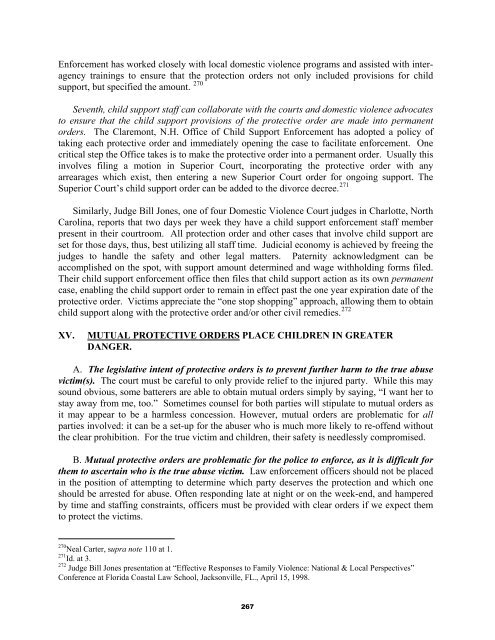A Judge’s Guide
A Judge’s Guide
A Judge’s Guide
Create successful ePaper yourself
Turn your PDF publications into a flip-book with our unique Google optimized e-Paper software.
Enforcement has worked closely with local domestic violence programs and assisted with interagency<br />
trainings to ensure that the protection orders not only included provisions for child<br />
support, but specified the amount. 270<br />
Seventh, child support staff can collaborate with the courts and domestic violence advocates<br />
to ensure that the child support provisions of the protective order are made into permanent<br />
orders. The Claremont, N.H. Office of Child Support Enforcement has adopted a policy of<br />
taking each protective order and immediately opening the case to facilitate enforcement. One<br />
critical step the Office takes is to make the protective order into a permanent order. Usually this<br />
involves filing a motion in Superior Court, incorporating the protective order with any<br />
arrearages which exist, then entering a new Superior Court order for ongoing support. The<br />
Superior Court’s child support order can be added to the divorce decree. 271<br />
Similarly, Judge Bill Jones, one of four Domestic Violence Court judges in Charlotte, North<br />
Carolina, reports that two days per week they have a child support enforcement staff member<br />
present in their courtroom. All protection order and other cases that involve child support are<br />
set for those days, thus, best utilizing all staff time. Judicial economy is achieved by freeing the<br />
judges to handle the safety and other legal matters. Paternity acknowledgment can be<br />
accomplished on the spot, with support amount determined and wage withholding forms filed.<br />
Their child support enforcement office then files that child support action as its own permanent<br />
case, enabling the child support order to remain in effect past the one year expiration date of the<br />
protective order. Victims appreciate the “one stop shopping” approach, allowing them to obtain<br />
child support along with the protective order and/or other civil remedies. 272<br />
XV. MUTUAL PROTECTIVE ORDERS PLACE CHILDREN IN GREATER<br />
DANGER.<br />
A. The legislative intent of protective orders is to prevent further harm to the true abuse<br />
victim(s). The court must be careful to only provide relief to the injured party. While this may<br />
sound obvious, some batterers are able to obtain mutual orders simply by saying, “I want her to<br />
stay away from me, too.” Sometimes counsel for both parties will stipulate to mutual orders as<br />
it may appear to be a harmless concession. However, mutual orders are problematic for all<br />
parties involved: it can be a set-up for the abuser who is much more likely to re-offend without<br />
the clear prohibition. For the true victim and children, their safety is needlessly compromised.<br />
B. Mutual protective orders are problematic for the police to enforce, as it is difficult for<br />
them to ascertain who is the true abuse victim. Law enforcement officers should not be placed<br />
in the position of attempting to determine which party deserves the protection and which one<br />
should be arrested for abuse. Often responding late at night or on the week-end, and hampered<br />
by time and staffing constraints, officers must be provided with clear orders if we expect them<br />
to protect the victims.<br />
270<br />
Neal Carter, supra note 110 at 1.<br />
271<br />
Id. at 3.<br />
272<br />
Judge Bill Jones presentation at “Effective Responses to Family Violence: National & Local Perspectives”<br />
Conference at Florida Coastal Law School, Jacksonville, FL., April 15, 1998.<br />
267


